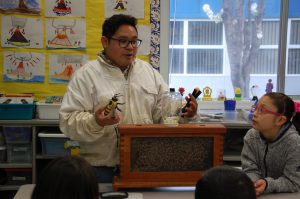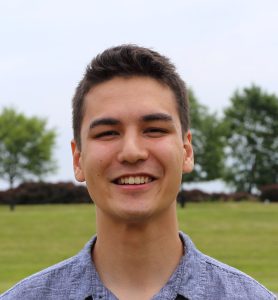The UC Davis Series
By: Brian R. Johnson
Hello Beekeepers! This short article will introduce you to the Johnson Bee Lab at UC Davis. Our lab shares the Laidlaw Bee Lab, which is just off the Davis campus, with two other labs, that of Elina Niño and Neal Williams. Our work complements one another and together we cover quite a lot of bee biology. I work mainly on basic science with honey bees, although we do some applied work as well, while Elina works mainly on applied science with a smaller role for basic work. Neal works on non-Apis honey bees, sometimes called native bees. I’ll leave detailed introductions to each of their work to them. Here I’ll try to cover what we do in my lab and why I think it’s interesting and important for beekeepers.

Brian Johnson
I’ll start with introductions. I went to college at UC San Diego and did my PhD at Cornell University with Tom Seeley. I studied mainly behavioral ecology as a student but switched to genetics during my two postdoctoral research jobs (one at UC San Diego with James Nieh and the other at UC Berkeley with Neil Tsutsui). I was hired at UC Davis in 2011 and have been here ever since. I currently have three graduate students in my lab (introductions to come), and the bee lab technician, Joseph Tauzer, who is shared between all three labs. Joe does quite a lot of beekeeping for our group, although I require each student to do a significant amount of their own beekeeping. We have two laboratory spaces, one on campus, which is where we do molecular biology, and the other at Laidlaw where field work is done.
So, what attracted me to bees? I did not grow up keeping bees, and in all honesty, I was not terribly interested in them as a college student. In the beginning of my scientific studies, I was mainly attracted to evolution and behavior in a general sort of sense. I did have a particular interest in the social behavior of insects, however. I love how their large colonies are like puzzles full of different pieces that work together. As a student I read several books about social insects and enjoyed Tom Seeley’s The Wisdom of the Hive the most, which led to my applying to Cornell. So, in short, I study bees somewhat by accident since I would have been just as happy with ants or termites. However, I am glad that I fell into honey bee research. The honey bee is the most amenable to study of all the social insects (maybe all the insects) and we know more about it than we do about almost any other organism. This allows one to go deeper into their biology and do research that would be difficult or impossible with other animals. Also, bees are just fascinating creatures. Basically, I have grown to love the honey bee. To put all of this into a take home principle, there are two kinds of bee scientists: those who love bees, and those who use bees and a model system for the science questions they find interesting. I started out as the second but have grown into a person who encompasses both.
Having covered the basics, we can now get down to what kind of research we do in my lab. My own research covers two main topics. First, I am interested in how a colony is designed. This is sometimes called division of labor, or organization of work. It is basically who does what in the nest and how. I have worked quite a lot on the caste concept, for example, which organizes the bees in the colony into four temporal castes: newly emerged, nurse, middle aged and foragers. Bees pass through these phases as they age. The biology is quite similar to that which controls puberty in ourselves. When we’re juveniles, we have hormone levels that lead to juvenile physiology and behavior. When we go through puberty, the hormone levels change and that leads to the development of different physiology and morphology (secondary sex characteristics) and behavior. Bees do the same. Each time they change caste, their hormones change to optimize their behavior and physiology for their new role in the nest. This can mean turning on brood food production in nurses, for example, or activating parts of the brain to prepare for the complexity of foraging. I study what triggers a change from one caste to the next, and what genes are involved. I also explore what each caste does in detail and how they communicate with one another.
My second interest is in the evolution of social behavior. Here the goal is to understand how a solitary bee evolved first into a simple social bee and later into a complex large colony like that of the honey bee. There are many ideas in this field but the main one has stressed that from a genetic perspective, the same genes are used in solitary and social bees. This is sometimes called the “genetic toolkit” idea. It is thought that the same genes evolve new roles in the social bees. There is certainly a lot of truth to this idea. We have many of the same genes that are in mice, for example, and even bees. Some of these genes do the same things (like making energy which is something needed by all living things) but sometimes the same genes do different things in different animals. My own work has focused on an alternative idea to the toolkit idea (not mutually exclusive) that different animals have different unique genes that give them some of their individuality. Bees, for example, have bee genes (or genes limited to them and their close relatives like ants and wasps). Some of the bee genes, for example, play roles in immunity, in brood food production and in defense (venoms). I have stressed in my evolutionary writings that both toolkits and unique genes are necessary for major evolutionary change, such as that which turned a solitary bee into a colony of many thousands.

Adrian Perez
The students in my lab pursue a variety of topics. In general, there are different philosophies regarding how to run a lab. Some scientists have their research planned out years in advance and require that everyone who joins their lab work on these projects in some capacity. They may allow some leeway (or none) but the topics and the basics questions are chosen for the students. Other scientists allow the students to choose their own topic (or that of the advisers) depending on their personality and goals. Of course, most people are somewhere between these two extremes. Moreover, there is much to be said for both approaches as there are pros and cons, in terms of the job market, associated with each. It’s easier to get involved in important research if you are plugged into ongoing important research, for example. However, to show that you are capable of independent research and have your own ideas, it is best to develop your own project. I fall strongly into the second category so my students work on whatever they like.
I currently have two students who work on bees. My most senior graduate student, Adrian Perez, has worked on disease dynamics in bees. He has explored how bees interact with one another, in the hope of discovering how they limit the spread of pathogens. He is currently interested in how drones may transmit disease between colonies (a widely known but understudied problem).

Marshall Nakatani
The other bee student, Marshall Nakatani, is beginning work on the time keeping mechanisms of bees. Bees are famous for using their clocks in many ways, such as to remember when a particular flower patch was blooming. It is also known that nurses do not have a circadian rhythm while the older bees do. These traits make bees good models for studying the molecular biology of the clock.
My last student, Nicole Korzeniecki, works on disease dynamics in termites. Termites have a lot in common with the social Hymenoptera (ants, bees and wasps) but are poorly studied relative to them. Termites have interesting social immunity behavior, in particular, with infected termites signaling to their nestmates that they need help. Nicole is exploring what controls this signaling and how effective it is at preventing disease.

Nicole Korzeniecki
Apart from research, I have two main other activities: teaching and writing books. I teach insect behavior, but more relevant to this article, I teach a yearly class in bee biology. Here, I cover all the fundamentals of both basic and applied bee science. I also introduce the students to beekeeping. It is a popular class and I enjoy teaching it. In particular, teaching the class forces me to keep up to date on all the research happening across many topics on bees. This wide-ranging study helped in the writing of my first book, Honey Bee Biology which was published by Princeton University Press last year. This book was designed to be an updated version of the classic, The Biology of the Honey Bee by Mark Winston. That was, and still is, a wonderful book that served as the standard reference for bee science for many decades. Unfortunately, it is about 30 years old now and some topics are out of date. A new book was thus necessary, and I was glad to write it. I also recently wrote a book on beekeeping, Introductory Beekeeping: How to get Started and Grow as a Beekeeper which is available, along with the first book, on Amazon. This book covers the basics of beekeeping but provides more biology and natural history than you tend to find in these books. I am currently working on a book on the bee crisis (Colony Collapse Disorder and the chronically high losses we’ve seen since). It is still early going on this book, so I will have to update you on its thesis and due date later.
I hope this introduction to our lab was interesting. In coming articles, I will drill down on particular topics in bee science. This serves two functions. First, I find that most beekeepers are simply interested in the biology of their beloved bees. They are fascinating animals after all. Second, in many cases knowing the biology (behavior and natural history in particular) of the bees will help you in your beekeeping. There are many cases where it is not clear what to do, for example, and you have to make a guess. In these situations, the more you know about bees (from every perspective) the better your guess will be. I will give many examples in articles to come.
Brian Johnson
Department of Entomology and Nematology
One Shields Ave
University of California, Davis
Davis, CA 95616










